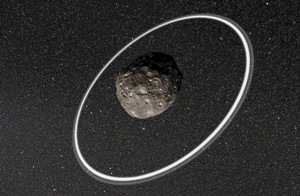Mar 29 2014
Happenstance led to the discovery of the first ring system around an asteroid, and Appalachian State University Professor Joseph Pollock was part of the team of astronomers that made the discovery.
 This artist’s impression shows how the rings around Chariklo might look from space. (Image courtesy of the European Southern Observatory)
This artist’s impression shows how the rings around Chariklo might look from space. (Image courtesy of the European Southern Observatory)
The team’s result has been published in the March 26 issue of the online journal Nature and on the European Southern Observatory’s website at http://www.eso.org. ESO is an intergovernmental astronomy organization in Europe.
The asteroid, named Chariklo, was found to have two rings. Chariklo orbits the Sun between the orbits of Saturn and Uranus.
Pollock and others were monitoring the predicted disappearance (called an occultation by astronomers) of a star as Chariklo passed in front of that star as viewed from the Earth, when they observed unexpected dips in the star’s brightness before and after Chariklo itself blocked the star. The dips were determined to have occurred when the asteroid’s two-ring system passed in front of the star. “Those dips were the first indication of the ring system,” Pollock said.
Pollock recorded the fluctuations in the star’s brightness from Chile using the Prompt observatory on Cerro Tololo. Prompt is part of the SKYNET network of robotic telescopes, which also has telescopes located in Australia, Europe and the U.S., including two telescopes at Appalachian’s Dark Sky Observatory. SKYNET was developed by UNC Chapel Hill starting in 2006 with funding from the National Science Foundation.
“I have been making extensive use of the SKYNET telescopes located on Cerro Tololo in Chile since 2007 for the asteroid research work that I do,” he said. “About a year and a half ago, as part of an international collaboration, I started using them to attempt to make observations of occultations of stars by small objects like Chariklo in the outer solar system.” Pollock said such data can be used to determine the shape and size of the object as a result of observing the occultation.
Comparing the data collected by Pollock and others confirmed the rings’ existence. Until now, rings have been found exclusively around the four giant planets in the Solar System, according to information from the European Southern Observatory, which coordinated the research.
“As part of a major collaborative effort last June, I used three of the telescopes at Cerro Tololo to observe the Chariklo as it passed in front of a star,” Pollock said. “About a dozen observatories in South America participated. Not only did the telescopes detect when the asteroid blocked out the star, but they also detected when something very near to Chariklo briefly blocked light as well. By putting together similar results from all of the participating observatories, it was possible to conclude that the asteroid had a ring system around it as well as determine that the object itself was not round. The current estimate for Chariklo’s size is about 160 miles. For comparison purposes our Moon is about 2,100 miles in diameter.”
“We weren’t looking for a ring and didn’t think small bodies like Chariklo had them at all, so the discovery – and the amazing amount of detail we saw in the system – came as a complete surprise,” said Felipe Braga-Ribas (Observatório Nacional/MCTI, Rio de Janeiro, Brazil) who planned the observation campaign and is lead author on the research paper.
Chariklo is surrounded by two dense and narrow rings, according to the Nature article. It is the smallest object found to have rings and only the fifth body in the Solar System – after the much larger planets Jupiter, Saturn, Uranus and Neptune – to have this feature. The origin of these rings remains a mystery, but they may be the result of a collision that created a disc of debris, the publication reports.
According to the ESO news release, “The rings may prove to be a phenomenon that might in turn later lead to the formation of a small moon. Such a sequence of events, on a much larger scale, may explain the birth of our own Moon in the early days of the Solar System, as well as the origin of many other satellites around planets and asteroids.”